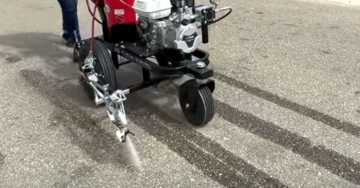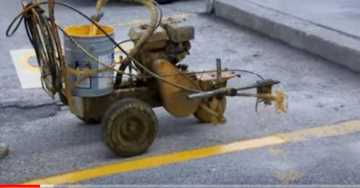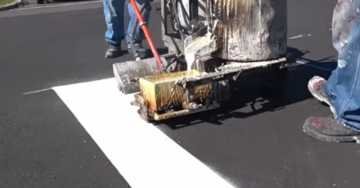As a licensed civil engineer and construction specialist with over 25 years of experience in asphalt materials, specifications, and roadway construction, I have witnessed the crucial role that parking lot striping plays in ensuring safety, organization, and efficient traffic flow. From large commercial complexes to residential communities, proper striping is an essential aspect of any well-designed parking facility.
The Significance of Parking Lot Striping
Safety and Accessibility
Parking lot striping is primarily designed to enhance safety and accessibility for both pedestrians and vehicles. By clearly delineating traffic lanes, parking spaces, and pedestrian walkways, striping helps to minimize the risk of accidents and collisions. Additionally, it ensures compliance with accessibility regulations, such as the provision of designated accessible parking spaces and appropriate markings.
Organization and Efficiency
Well-executed striping contributes to the overall organization and efficiency of a parking lot. Clearly defined parking spaces and directional markings help drivers navigate the facility with ease, reducing confusion and minimizing the time spent searching for available spots. This, in turn, can lead to improved customer satisfaction and a more pleasant overall experience.
Striping Materials and Application
Necessary Equipment for Parking Lot Striping
Striping Machines
The foundation of any parking lot striping project is the striping machine. These specialized pieces of equipment are designed to efficiently and accurately apply paint or thermoplastic markings to the pavement surface. When selecting a striping machine, consider the following factors:
Type of Marking Material:
Choose a machine that is compatible with the type of material you’ll be using, whether it’s paint or thermoplastic.
Line Width Adjustability:
Look for machines that allow you to adjust the line width to accommodate different parking spaces and lane requirements.
Power Source:
Decide whether you prefer a gas-powered, electric, or battery-powered striping machine based on your project needs and environmental considerations.
Maneuverability:
Opt for a machine that offers good maneuverability, particularly in tight spaces, to ensure precise and consistent line work.

Paint-Based Striping
One of the most common methods for parking lot striping is the use of specialized traffic paints. These paints are formulated to provide high visibility, durability, and resistance to various environmental factors, such as UV radiation and abrasion.

Application Techniques
The application of paint-based striping can be accomplished through several techniques, including:
- Airless Spray Painting: This method involves the use of specialized airless spray equipment to evenly and efficiently apply the paint.
- Roller Application: For smaller areas or touch-ups, roller application can be an effective and cost-efficient option.

Advantages and Disadvantages
While paint-based striping is generally cost-effective and easy to apply, it may require more frequent maintenance and reapplication due to wear and tear. Additionally, certain paints may have environmental concerns or limited durability in extreme weather conditions.
Thermoplastic Striping
Thermoplastic striping is an increasingly popular alternative to traditional paint-based methods. This technique involves the application of preformed thermoplastic materials, which are heated and extruded onto the pavement surface.

Application Process
The application of thermoplastic striping typically involves the following steps:
- Surface Preparation: The pavement surface is cleaned and prepared to ensure proper adhesion.
- Material Heating: The thermoplastic material is heated to a specific temperature, allowing it to become malleable.
- Extrusion: The heated material is extruded onto the pavement surface, forming the desired striping pattern.
- Cooling and Curing: The extruded material is allowed to cool and cure, resulting in durable and long-lasting striping.
Advantages and Disadvantages
Thermoplastic striping offers superior durability, abrasion resistance, and longer service life compared to paint-based systems. However, it may be more expensive and require specialized equipment and skilled labor for installation.
Choosing Paint or Thermoplastic Markings
The choice between paint and thermoplastic markings for your parking lot striping project will depend on factors such as expected traffic, desired durability, and budget. Consider the following:
Paint:
In my experience, Water-based or solvent-based paints are a more affordable option, but they may require more frequent reapplication, especially in high-traffic areas.
Thermoplastic:
In my experience, Thermoplastic markings are more durable and long-lasting, but they come with a higher upfront cost and require specialized application equipment.
Stencils and Accessories
In addition to the striping machine and marking material, you’ll need a variety of accessories to complete your parking lot striping project:
Stencils:
Stencils are essential for creating symbols, arrows, and other pavement markings with precision.
Chalk Lines:
Use chalk lines to establish straight, even lines and layouts before applying the markings.

Safety Gear:
Proper personal protective equipment (PPE), such as safety glasses, gloves, and high-visibility clothing, is crucial for the safety of your work crew.
Parking Lot Striping Techniques
Surface Preparation
Before applying any pavement markings, it’s essential to thoroughly prepare the parking lot surface. This includes:
Cleaning:
Remove any debris, oil, or other contaminants from the pavement surface to ensure proper adhesion of the markings.
Repairs:
Address any cracks, potholes, or other pavement defects to create a smooth, uniform surface.
Drying Time:
Allow the parking lot to fully dry after any necessary repairs or cleaning before proceeding with the striping.
Layout and Marking
Establishing a proper layout and marking plan is crucial for a professional-looking and efficient parking lot striping project. Consider the following steps:
Measure and Mark:
Use chalk lines to accurately measure and mark the desired parking space dimensions, lane widths, and other pavement markings.
Stencil Placement:
Position stencils carefully to ensure that symbols, arrows, and other markings are properly aligned and spaced.
Spray Technique:
When applying the paint or thermoplastic material, maintain a consistent speed and height of the striping machine’s spray gun or applicator to ensure uniform line work.
Curing and Drying Time
The curing and drying time for the pavement markings will depend on the type of material used:
Paint:
In my experience, Water-based and solvent-based paints typically dry within 15-30 minutes but may require several hours to fully cure.
Thermoplastic:
In my experience, Thermoplastic markings require a longer curing time, often up to 30 minutes, to allow the material to properly adhere to the pavement surface.
Addressing Common Challenges
During the parking lot striping process, you may encounter various challenges that require specific techniques to overcome. Some common issues and solutions include:
Uneven or Cracked Pavement:
Use a patching compound or sealant to address any surface irregularities before applying the markings.
Wet or Damp Conditions:
Postpone the striping project until the pavement is completely dry to ensure proper adhesion of the markings.
Fading or Wear:
Schedule regular maintenance and reapplication of pavement markings to maintain the desired appearance and safety of the parking lot.
I’ll share real-life case studies that demonstrate how I’ve successfully overcome some of the most common issues encountered during the parking lot striping process.
Case Study Florida: Uneven or Cracked Pavement
The Challenge
The parking lot at a busy shopping center had experienced significant wear and tear over the years, resulting in uneven surfaces, cracks, and potholes throughout the pavement. The property manager wanted to have the lot restriped but was concerned that the surface irregularities would compromise the appearance and durability of the new pavement markings.
The Approach
To address the uneven and cracked pavement, my team first conducted a thorough inspection of the lot to identify the extent and severity of the issues. We then developed a comprehensive surface preparation plan that involved the following steps:
Patching and Leveling:
We used a specialized asphalt patching compound to fill in the cracks and potholes, ensuring a smooth and level surface.
Surface Grinding:
In areas with more significant unevenness, we employed a pavement grinder to remove high spots and create a uniform surface.
Sealant Application:
After the patching and grinding, we applied a high-quality pavement sealant to the entire lot, protecting the surface from future deterioration.
The Outcome
By taking the time to properly prepare the parking lot surface, we were able to create a smooth and level foundation for the new pavement markings. The property manager was thrilled with the results, as the striping was applied evenly and consistently, enhancing the overall appearance and safety of the parking lot.
Case Study Miami: Sea Level Wet or Damp Conditions
The Challenge
A large hospital had scheduled a parking lot striping project during the rainy season, as it was the only time the lot could be closed for the necessary work. The maintenance team was concerned that the wet conditions would prevent the pavement markings from adhering properly, leading to premature fading and wear.
The Approach
Recognizing the importance of addressing the wet conditions, we took the following steps to ensure the success of the striping project:
Postponement and Rescheduling:
We advised the hospital to postpone the striping project until a drier period, as applying pavement markings to a wet surface would significantly compromise their adhesion and longevity.
Thorough Surface Inspection:
Once the weather improved, we conducted a detailed inspection of the parking lot, checking for any remaining moisture or moisture-related issues that could affect the striping.
Careful Timing:
We carefully timed the striping application to take advantage of the optimal weather conditions, ensuring the pavement was completely dry before proceeding.
The Outcome
By rescheduling the project and taking the necessary precautions, we were able to apply the pavement markings under ideal conditions. The hospital staff was pleased with the long-lasting results, as the striping maintained its vibrant appearance and consistent application throughout the lot.
Case Study California: Fading or Wear
The Challenge
A large retail complex had recently had its parking lot restriped, but within a few months, the pavement markings began to show signs of significant fading and wear, particularly in high-traffic areas. The property manager was concerned about the safety implications and the overall aesthetic of the lot.
The Approach
To address the fading and wear issues, we implemented the following strategies:
Evaluation and Analysis:
We conducted a thorough assessment of the parking lot to determine the root causes of the fading and wear, which included factors such as heavy traffic, exposure to the elements, and the use of suboptimal marking materials.
Reapplication and Maintenance Plan:
Based on our findings, we developed a comprehensive maintenance plan that included regular reapplication of the pavement markings, particularly in the high-traffic areas. We also recommended the use of more durable, high-quality marking materials to better withstand the demands of the parking lot.
Ongoing Monitoring:
We established a schedule for regularly monitoring the condition of the pavement markings and promptly addressing any issues that arose, ensuring the long-term safety and visual appeal of the parking lot.
The Outcome
By implementing the maintenance plan and using more durable marking materials, we were able to significantly extend the lifespan of the pavement markings and maintain a consistent, professional appearance throughout the parking lot. The property manager was grateful for the solution, as it addressed their safety concerns and improved the overall aesthetics of the facility.
Comparison of Parking Lot Striping Equipment and Materials
To help you make an informed decision when selecting the right equipment and materials for your parking lot striping project, I’ve compiled a comparison table:
| Feature | Paint | Thermoplastic |
|---|---|---|
| Cost | Lower upfront cost | Higher upfront cost |
| Durability | Moderate to high, depending on the paint type | High, very durable, and long-lasting |
| Application | Sprayed or rolled onto the pavement | Requires specialized application equipment to melt and apply the material |
| Curing Time | Dries quickly, 15-30 minutes | Longer curing time, up to 30 minutes |
| Reflectivity | Can be enhanced with glass beads | Inherently reflective |
| Maintenance | Requires more frequent reapplication | Less frequent reapplication required |
| Environmental Impact | Water-based paints are more environmentally friendly | Thermoplastic materials may have a higher environmental impact |
| Recommended Usage | Lower-traffic areas, temporary markings | High-traffic areas, permanent markings |
Design Considerations
Compliance with Regulations
When designing and executing parking lot striping, it is crucial to ensure compliance with local, state, and federal regulations. These regulations often dictate specific requirements for line widths, markings, and the dimensions of parking spaces, including accessible spaces.
Accessible Parking Spaces
Accessible parking spaces must be designed and marked by the Americans with Disabilities Act (ADA) guidelines or similar regulations in other countries. These guidelines specify the required dimensions, markings, and signage for accessible spaces to ensure proper access and usability for individuals with disabilities.
Visibility and Contrast
Proper visibility and contrast are essential for effective parking lot striping. The use of high-visibility paints or materials, as well as the consideration of contrast against the pavement surface, can significantly enhance the legibility and safety of the striping.
Retroreflective Markings
In areas with low light conditions or high pedestrian traffic, the use of retroreflective markings can be beneficial. These markings utilize specialized materials or coatings that reflect light back toward the source, improving visibility and enhancing safety for both drivers and pedestrians.
Maintenance and Longevity
Regular maintenance and periodic reapplication are essential for ensuring the longevity and effectiveness of parking lot striping. Factors such as weather conditions, traffic volume, and the quality of the initial installation can impact the lifespan of the striping.
Maintenance Schedules
Developing and adhering to a comprehensive maintenance schedule is crucial for maintaining the quality and visibility of the striping. This may involve regular inspections, touch-ups, or complete reapplication when necessary.
Parking Lot Striping Dataset
To provide a comprehensive understanding of parking lot striping, I have compiled the following dataset tables:
Table 1: Design Perspective
| Parameter | Description |
|---|---|
| Line Width | Typical line widths range from 4 to 6 inches (10 to 15 cm) for parking stalls and traffic lanes. |
| Stall Dimensions | Standard parking stall dimensions are 9 feet (2.7 m) wide by 18 feet (5.5 m) long for perpendicular spaces, with variations for angled spaces. |
| Accessible Spaces | Minimum width of 8 feet (2.4 m) with an adjacent access aisle of at least 5 feet (1.5 m) wide. |
| Markings | Directional arrows, stop bars, crosswalks, and other markings should be clearly visible and comply with regulations. |
| Drainage | Proper drainage and grading should be considered to prevent water accumulation and potential hazards. |
Table 2: Safety Measures
| Safety Measure | Description |
|---|---|
| Visibility | High-visibility materials, adequate contrast, and retroreflective markings should be used for enhanced visibility. |
| Signage | Clear and compliant signage should be installed, including accessible space markings and directional signage. |
| Lighting | Adequate lighting should be provided, especially in areas with high pedestrian traffic or low light conditions. |
| Speed Bumps | Speed bumps or other traffic calming measures may be implemented in areas with high pedestrian activity. |
| Curb Ramps | Properly designed and marked curb ramps should be provided for accessibility and pedestrian safety. |
Table 3: Cost Parameters
| Cost Factor | Description |
|---|---|
| Material Selection | Costs can vary significantly based on the chosen material (paint, thermoplastic, etc.) and quality. |
| Surface Preparation | Proper surface preparation, including cleaning and repairs, can impact overall costs. |
| Labor | Skilled labor costs can vary based on the complexity of the project and the contractor’s expertise. |
| Maintenance | Regular maintenance and periodic reapplication can contribute to ongoing costs over time. |
| Specialized Equipment | Specialized equipment, such as thermoplastic extruders or striping machines, may require additional investment. |
Throughout my career, I have had the privilege of working on numerous parking lot striping projects, from small residential complexes to large-scale commercial and industrial facilities. Each project has presented its unique challenges and opportunities, allowing me to continuously hone my skills and expand my knowledge.
If I conclude my 25+ years of experience in parking lot design than an Effective parking lot striping is a critical aspect of any well-designed parking facility, contributing to safety, organization, and efficiency. By carefully considering factors such as material selection, design considerations, and maintenance requirements, parking lot striping can significantly enhance the overall user experience and ensure compliance with relevant regulations.
I am well-equipped to guide clients through the intricate process of parking lot striping. My expertise, combined with a commitment to staying up-to-date with the latest industry advancements, allows me to provide tailored solutions that meet the specific needs of each project.
Key Takeaways
- Prioritize safety and accessibility by incorporating clear and compliant striping in your parking lot design.
- Consider the long-term durability and maintenance requirements when selecting striping materials and application methods.
- Engage experienced professionals with a deep understanding of regulations, design principles, and industry best practices.
- Regularly maintain and inspect your parking lot striping to ensure optimal performance and longevity.
- Stay informed about the latest advancements in striping technologies and materials to maximize the value of your investment.
Personal Experience and Expertise
As Steve Axton, I have dedicated over 25 years to the field of road construction and asphalt pavements, amassing a wealth of knowledge and practical experience. Throughout my career, I have had the opportunity to work on a diverse range of projects, from residential developments to large-scale commercial and industrial facilities.
My expertise extends beyond parking lot striping, encompassing the entire spectrum of asphalt material specifications, roadway construction, and maintenance practices. I take great pride in my ability to provide comprehensive solutions that not only meet but exceed industry standards and client expectations.
Common Concerns About Parking Lot Striping
How often should parking lot striping be reapplied?
The frequency of reapplication depends on various factors, including the striping material used, traffic volume, and weather conditions. Generally, paint-based striping may need to be reapplied every 1-2 years, while thermoplastic striping can last 3-5 years or more.
Is it necessary to close the parking lot during striping?
In most cases, it is recommended to close or section of the area being striped to ensure the safety of workers and allow for proper curing or drying of the materials.
Can striping be applied to existing markings?
It is generally not recommended to apply new striping over existing markings, as this can lead to poor adhesion and visibility issues. Proper surface preparation, including the removal of old markings, is crucial for optimal results.
Are there specific regulations for handicapped parking spaces?
Yes, the Americans with Disabilities Act (ADA) and other accessibility regulations dictate specific requirements for the dimensions, markings, and signage of accessible parking spaces.
Can striping be applied in cold weather conditions?
Cold weather can impact the application and curing of certain striping materials, such as paints or thermoplastics. It is important to follow the manufacturer’s recommendations for temperature and weather conditions during application.
How long does it take for striping to dry or cure?
The drying or curing time can vary depending on the material used, weather conditions, and the application method. Paint-based striping may dry within a few hours, while thermoplastic striping can take several hours to cool and cure completely.
Is there a difference between striping for parking lots and roadways?
While the materials and application methods may be similar, parking lot striping typically involves different design considerations and regulations compared to roadway striping. Parking lots often require additional markings for parking spaces, accessible areas, and pedestrian walkways.
Can striping be applied to concrete surfaces?
Yes, striping can be applied to both asphalt and concrete surfaces, but the surface preparation and material selection may vary depending on the substrate.
Are there environmentally friendly striping options available?
Yes, there are various eco-friendly striping options available, such as water-based paints, low-VOC materials, and sustainable thermoplastic formulations. These options aim to reduce environmental impact while maintaining performance and durability.
How can you ensure the longevity of parking lot striping?
To ensure the longevity of parking lot striping, it is crucial to select high-quality materials, follow proper surface preparation and application methods, and implement a regular maintenance and inspection schedule. Addressing any issues promptly can help extend the lifespan of the striping.
Can striping be customized with logos or specific designs?
Yes, striping can be customized to incorporate logos, graphics, or specific designs. This is often achieved through the use of stencils, templates, or specialized application techniques, and can be an effective way to enhance the branding or aesthetics of a parking facility.
By continuously expanding my knowledge, staying abreast of the latest industry advancements, and leveraging my extensive practical experience, I remain committed to providing exceptional parking lot striping solutions that prioritize safety, functionality, and long-term value for my clients.
